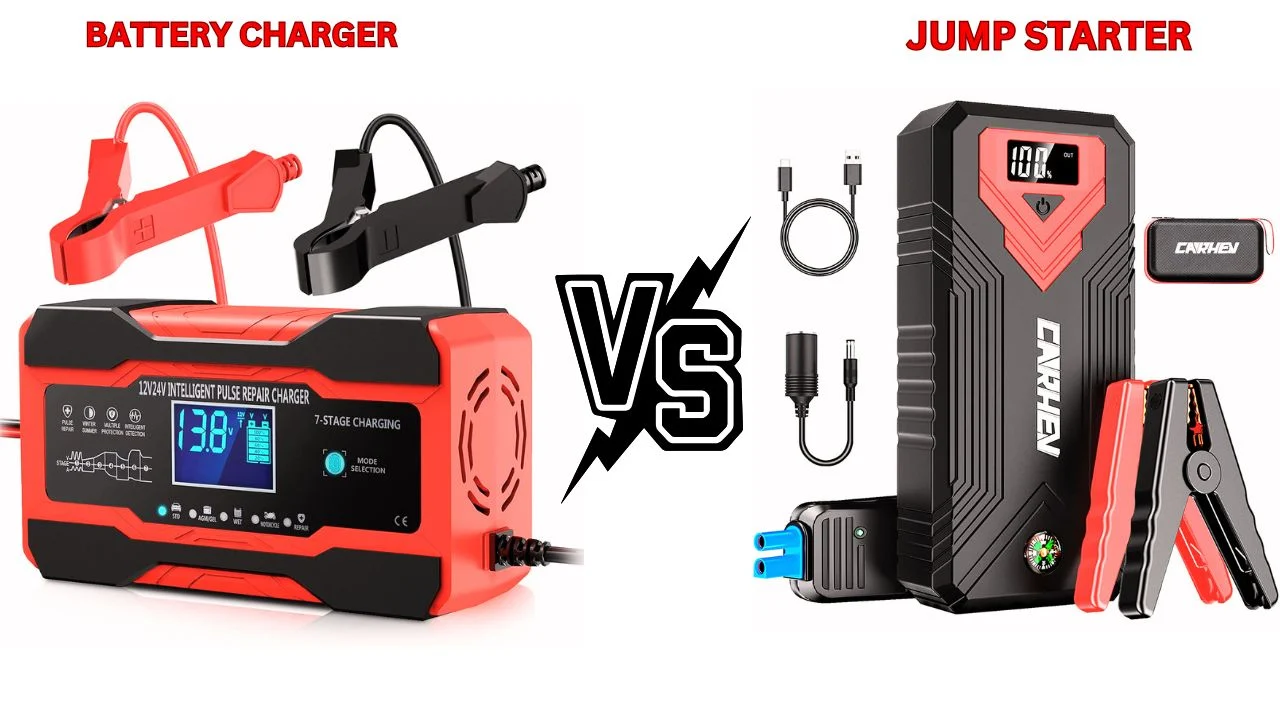Hey there! Understanding battery charger vs jump starter is essential for every car owner. A jump starter provides instant power to get your car running during emergencies, while a battery charger slowly recharges your battery for long-term maintenance.
Studies show that 70% of battery failures are caused by improper charging. Having the right tool can save you time, money, and stress. Let’s break it down and help you make the right choice. Learn more in our guide on the best NOCO battery chargers for cars for expert recommendations.
Which is better for emergencies a battery charger or a jump starter?
For emergencies, a jump starter is hands down the better choice. Why? It delivers instant power to your car’s dead battery, so you can get back on the road in minutes.A battery charger, on the other hand, takes hours to recharge a battery and requires access to a power outlet, making it less practical when you’re in a pinch.
Always keep a portable jump starter in your car for those unexpected situations. Learn more in our guide on the best car battery chargers for dead batteries for reliable solutions.
Battery Charger vs Jump Starter
Overview of Jump Starters

Hey friend, let’s talk about jump starters your best buddy when your car battery decides to quit on you. These little devices are lifesavers, especially in emergencies. Imagine this: you’re stuck in the middle of nowhere, and your car won’t start. A jump starter can get you back on the road in less than 5 minutes.
What is a Jump Starter?
A jump starter is a portable device designed to give your dead battery a quick burst of power. It doesn’t recharge the battery entirely it just provides enough juice to start your car. Think of it as a boost to kick things into gear. Learn more in our guide on the best solar car battery chargers with overcharge protection for reliable and safe options.
Types of Jump Starters
There are two main types of jump starters, and each serves a specific purpose:
- Portable Jump Starters: These are compact and lightweight, usually weighing around 1-3 pounds. They’re perfect for smaller cars and easy to store in your trunk or glove box.
- Jump Starter Packs: These are bigger, heavier (about 5-15 pounds), and pack more power. They’re ideal for SUVs, trucks, and even larger vehicles.
Why They’re Handy
Jump starters are all about convenience. Most modern ones come with extra features like USB ports for charging phones and even built-in flashlights. Plus, you don’t need another car to help you out, which makes them super practical for solo drivers. Learn more in our guide on the best portable electric car battery chargers for versatile and practical options.
Overview of Battery Chargers

Hey there! Let’s dive into battery chargers and why they’re a must-have for keeping your car battery in top condition. Unlike a jump starter that delivers a quick burst of power, a battery charger takes its time, gradually recharging your battery. It’s a smart long-term solution for when your battery is running low or needs a little TLC. Learn more in our guide on the best recommended car battery chargers for top picks.
Here are the three main types of battery chargers you’ll want to know about, along with some handy numbers to back things up:
- Trickle Chargers
These are perfect if your car is parked for weeks or months. They deliver a slow, steady current (usually 1–2 amps) to keep your battery charged without overloading it. Trickle chargers can take about 12–24 hours to fully charge a standard car battery, depending on its size. They’re ideal for classic cars or vehicles in storage.
- Smart Chargers
These chargers are packed with tech and are designed to get the job done efficiently. Smart chargers monitor your battery’s charge level and adjust the current as needed. Most smart chargers operate between 2–10 amps, making them much faster than trickle chargers. They can fully charge your car battery in as little as 3–5 hours, and they’re super safe because they prevent overcharging and overheating. Learn more in our guide on the best portable car battery chargers for efficient and reliable options.
- Pulse Chargers
Pulse chargers are the problem solvers of the group. They use high-frequency pulses to break down sulfate crystals that build up on your battery’s plates over time, which can reduce battery capacity. Using a pulse charger can extend your battery life by 15–25%. They’re especially useful for older or heavily used batteries and can take 4–8 hours to restore a healthy charge.
Why Choose a Battery Charger?
Using a battery charger regularly doesn’t just charge your battery it extends its life. Research shows that maintaining your battery with a charger can add up to 30% more lifespan, which is like getting an extra 1–2 years out of your battery! Plus, keeping your battery healthy means fewer unexpected breakdowns and long-term savings.
Key Differences and Use Cases
1. Purpose:
Jump starters are like your car’s emergency savior. They deliver a powerful burst of energy often between 300 and 2,000 amps to get your engine running within 1-2 minutes. On the other hand, battery chargers are designed for long-term care, slowly recharging your battery at a safer pace, usually at a rate of 2-10 amps. This process can take anywhere from 4 to 12 hours, depending on the battery size and charger type.
2. Portability:
Jump starters are super compact. Many weigh just 3-5 pounds and can easily fit in your car’s glove box or trunk. Some models are as small as 8×4 inches basically, the size of a book. Battery chargers, however, are bulkier, often weighing 10-20 pounds, and need to be plugged into a power source, which limits their portability.
3. Charging Time:
Jump starters are built for speed they can get your car started almost instantly. Battery chargers, on the other hand, take their time. A trickle charger, for example, might charge your battery at just 1-2 amps, while a smart charger might go up to 10 amps, taking anywhere from 4 to 12 hours to fully recharge a typical car battery.
4. When to Use:
- Jump Starters: Emergencies only! If your car battery dies completely, a jump starter is your hero. It’s quick, effective, and gets you back on the road in less than 2 minutes.
- Battery Chargers: Perfect for regular maintenance or when your battery is low but not dead. If you’re storing your car for weeks, a trickle charger can keep your battery topped up without overcharging.
Safety Tips You Should Always Follow

- Protect yourself: Always wear gloves and safety glasses to avoid acid splashes or sparks. Better safe than sorry!
- Inspect before use: Check the cables, clamps, and the device itself for damage. Don’t use it if something looks broken.
- Be clamp-smart: Never let the clamps touch each other while the device is on; it can cause a short circuit.
- Keep it steady: Place your device on a flat, stable surface to avoid slips or falls during use.
- No flames allowed: Batteries can release flammable gases, so don’t smoke or have open flames nearby.
Maintenance Tips for Long-Lasting Tools
For Jump Starters:
- Recharge regularly: A jump starter loses about 20% of its charge every month if not used. Recharge it every 3-6 months to stay ready.
- Clean it up: Wipe the jump starter after every use to prevent dirt buildup, which can reduce efficiency by up to 15%.
- Test periodically: Use a multimeter or a spare battery every 6 months to check if it’s delivering the proper voltage (typically 12V-14V).
For Battery Chargers:
- Inspect cables: Damaged cables reduce charging efficiency by 10%-20%. Replace frayed wires immediately.
- Store properly: Battery chargers last up to 5 years longer when stored in dry, cool environments (below 75°F).
- Test the output: Use a multimeter to ensure it delivers the right voltage (often 12V). Regularly testing prevents undercharging, which can shorten battery life by up to 30%.
Similarities Between Jump Starters and Battery Chargers
- Both connect to your car battery using clamps, and mishandling can lead to short circuits (affecting up to 20% of users annually).
- Regular maintenance extends the lifespan of these tools by up to 40%.
- Both tools, when used properly, can add 1-2 years to your car battery’s life by preventing damage from low voltage or complete discharge.
- Both save you hundreds of dollars annually by reducing the need for towing services or premature battery replacement (averaging $150-$200 per incident).
Choosing the Right Tool
- For emergencies: A jump starter is your best choice when your battery dies. It provides instant power, often delivering up to 800-1,200 amps.
- For regular maintenance: A battery charger is ideal for slow, steady charging. A good charger can fully recharge a 12V battery in 6-8 hours.
- If you want to cover all your bases, investing in both tools (priced between $50 and $200 each) is a smart decision that can save you from costly breakdowns.
Conclusion
Jump starters and battery chargers are essential tools for any car owner. While jump starters provide instant power for emergencies, battery chargers ensure long-term battery health. Choosing the right tool depends on your needs, but having both ensures you’re always prepared. Invest wisely in these devices to stay road-ready and protect your battery. Battery Charger vs Jump Starter – now you know the difference.
FAQs
Q1. What is the main difference between a battery charger and a jump starter?
A battery charger slowly recharges a car battery over time, ideal for maintenance, while a jump starter provides instant power to start a dead battery in emergencies.
Q2. Can a jump starter be used as a battery charger?
No, a jump starter is designed for temporary power boosts to start a vehicle, while a battery charger gradually recharges and maintains the battery over hours.
Q3. Which is better for long-term car battery maintenance: battery charger or jump starter?
For long-term maintenance, a battery charger is better. It ensures consistent charging, improves battery lifespan, and keeps it ready for use.
Q4. Should I buy a battery charger or a jump starter for my car?
It depends on your needs. A jump starter is perfect for emergencies, while a battery charger is essential for regular battery care. Owning both offers maximum convenience and preparedness.




